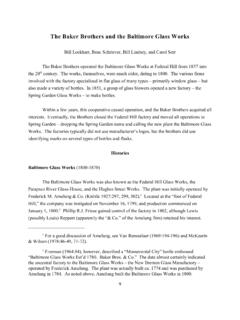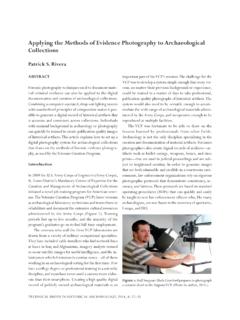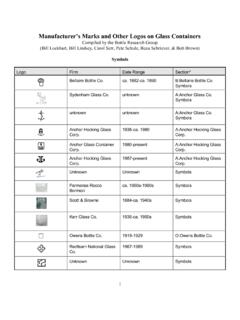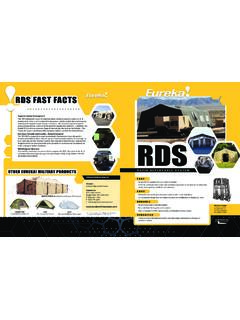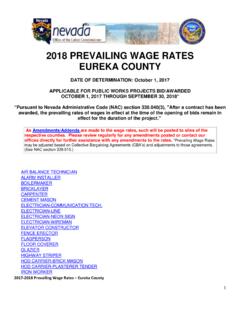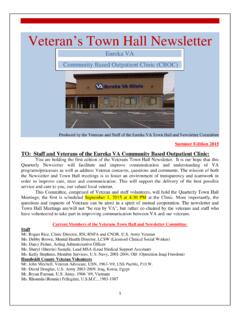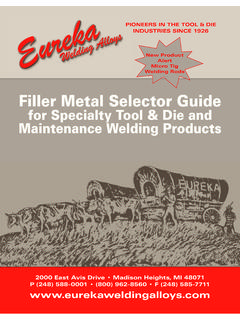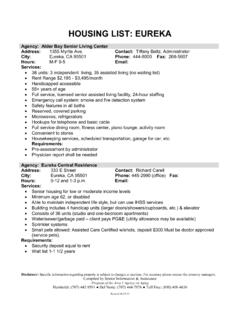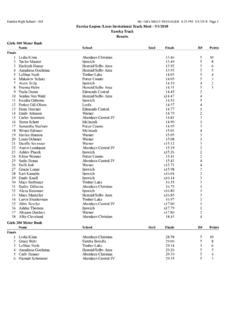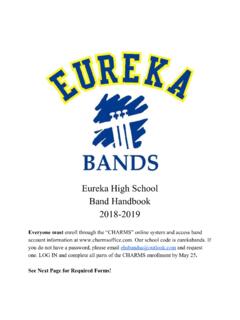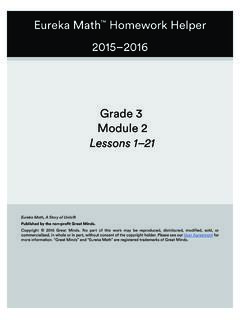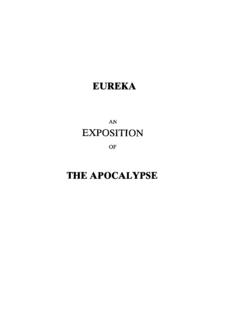Transcription of Eureka Jars and Their Makers
1 Figure 1 Early Eurekajar (North AmericanGlass) Eureka jars and Their MakersBill Lockhart, Beau Schriever, Bill Lindsey, and Carol SerrThree distinct fruit jars wore the name Eureka . These were manufactured bydifferent glass houses for different jobbers during different periods, and the most recentone was made in several variations. Unlike many fruit jars , each of these is datable to awell-defined period, and two of them were also used as product JarsEUREKA (1865-ca. 1870)Toulouse (1969:111-112) noted three variations of anaqua or colorless, handmade The first variation wasembossed Eureka (slight arch) / 1 / PATD DEC 27TH / 1864(all horizontal) on the side (Figure 1). A second jar was almostidentical but had the number 17 below Eureka . The thirdvariation was embossed PAT FEB 9TH & DEC 27TH 1864 in acircle on the side around Eureka , although no other sourcehas reported this variation, and we have not found an example.
2 Even though he could discover no information about thecompany, Toulouse dated the jar ca. (1983:118) listed two variations of this jar. Thefirst was identical to the initial variation listed by Toulouse,except that Roller noted that there may be a variety of numbersbelow Eureka (and showed a 22 on his photograph of thejar). He noted that the metal cap was embossed PATD JULY 18 1854 MAY 22D 1860 REISD NOV 24TH 1863. 1 None of the other sources mentioned this jar in colorless glass. As will be notedbelow, Toulouse confused two unrelated Eureka 3 Eureka jars (Creswick1987a:55)Figure 2 Ground rim(North American Glass)Roller noted the makeras uncertain but stated that Griffin advertised these jarsin 1865, and listed himself as Proprietor andManufacturer. Because theaddress was in lowerManhattan an improbablemanufacturing location it isunlikely that the jars were made there.
3 Caniff (2013:18)confirmed that there was no evidence that we re awareof indicating that Griffen had anything to do withactually making either the glass jar or the metal lids. Roller s second variation was the same, except that was embossed under Eureka in place of a number. He noted that the initials may have indicated Fansler was a jobber in Cleveland, Ohio, from 1865 to 1869. Fansler had hisfull name embossed on another type of jar (Roller 1983:118, 206). Also see the sectionon Samuel for another reference to the Fansler (1987a:55) illustrated the same variations as Roller and noted them ashaving a ground lip her designation for a handmade jar (Figures 2 & 3). She addedthat the patents taken out by Spratt and Sellers were eventually reissued to John Griffin. Otherwise, she followed Toulouse on both Roller editors (2011:184) included an unembossed jar that was 7" tall and 35/8" in diameter, with at an outer diameter of 2 " at the top of the finish.
4 The neck wastapered. There is an indentation in the neck just below the ground mouthto receive that rubber sealing gasket. The tinned iron cap has a straightportion below the top and then a flared portion at the bottom. Dick Rollerdidn t put [this jar] into the 1983 edition; even though, it was known tohim at the time. He referred to it as the Seller s Jar after the May 22,1860 patent registered to Theodore Sellers [although he failed to explainwhy he made that identification]302 Figure 4 Whittled jar(North American Glass)Figure 5 Eureka lid(North American Glass)We have not discovered anexample of the Toulouse thirdvariation, and it was not mentionedby any other source. We suggestthat Toulouse recorded thisvariation in error, possibly becauseof a faulty report. All exampleswe have found on North AmericanGlass and eBay had a one- or two-digit number embossed below Eureka , and these rangedfrom 1 to 17 plus a 22 reported by Roller.
5 Some of theseexamples had very heavy whittle marks an uneven surfacecaused by the use of cold molds (Figure 4).The examples from North American Glass had two main variations of lids mostwith a simple cap (see Figure 1). One, however, was more complex with a convex topand a rim (Figure 5). Creswick 1987a:55) illustrated a third type of lid with a recessedcenter (see Figure 3), although the Creswick type could be the same as the simple onefrom North American Glass. Unfortunately, none of the photos showed the top of the & Titus, New York City (ca. 1852-1865)Although John F. Griffen was listed as a crockery dealer at 82 Maiden La. in NewYork City in 1850, he had formed the partnership of Griffen & Titus with Stephen by 1852. The firm moved to 48 John St. in 1858. The pair advertised Ludlow sSelf-Sealing jars in tin, china, and glass by at least July 15, 1859, but by June 22, 1865,Griffen had sold his share to Haviland, and Haviland & Titus then operated the firm.
6 (Caniff 2013:17).303 John F. Griffen, New York City (1865-ca. 1870)Griffen reentered business alone at 9 Barclay St. and advertised himself as Proprietor and Manufacturer although he was certainly still a jobber in fruit jars andpossibly other goods. He had move to 142 Maiden La. by 1867. We have not discoveredhow long he remained in business, but other firms sold Eureka jars by at least 1867 suggesting that Griffin had opened his patent to other users (Caniff 2013:17, 19). Roller(2011:184) noted that Griffen was a crockery and glass dealer from 1850 to 1870. Unfortunately, we have no clues to suggest a manufacturer; virtually any factory in NewYork, Connecticut, New Jersey, or even more distant locations could have made the this is sheer speculation, Griffen may have separated from Titusbecause of his 1864 patent. The timing was certainly right.
7 The two may have disagreedon marketing, ownership, or any number of other issues, or Griffin may have just left totry his luck with the new jar on his own. Since Griffen did not receive the patent untilDecember 1864, the jars were likely made between 1865 and ca. PatentsRoller (1983:118) listed a metal cap associated with the Eureka jars that wasstamped with four patent dates that he attributed to:1. James Spratt, Cincinnati (1854)2. Theodore Sellers, East Birmingham, Pennsylvania (1860)3. John Griffen, New York, assigned to Theodore Sellers (1863)4. John F. Griffin, New York (1864)Griffen also had an earlier 1862 patent as well as two reissues in 1863. Griffen &Titus also sold the Ludlow jar, patented on August 6, 1861 (Caniff 2013:17-18).James Spratt July 18, 1854 According to Caniff (2013:18), glass lids on actual cans were embossed with SPRATT S PATENT JULY 18 1854 PAT D APRIL 5 1864 (Patent No.)
8 11,332). TheNew York Times described these as Infallible Fruit jars .. Spratt s Improved Tin Can304 Figure 6 Ludlow 1861 patentFigure 7 Ludlow jar(North American Glass)with glass covers on September 14, 1864 sold byGriffen & Titus Proprietors and Manufacturers. James Spratt assigned his 1854 patent ( ,332) to Griffen. Griffen received Reissue No. 1,593for Spratt s patent on December 22, 1863 (Caniff2013:17). For a much more detailed discussion of theSpratt patents, see the section on Arthur, Burnham &Gilroy in the A D. Ludlow August 6, 1861On August 6, 1861, Ludlow received PatentNo. 33,002 for an Improvement in Stopping jars (Figure 6). The closure was complex and was used on jars with lidsstamped with Ludlow patent dates of June 28, 1859, and August6, 1861 (Figure 7). For examples, see Roller (2011:299). Alsosee the Other L file for more information on Ludlow and (2013:17-18) noted that Griffen s 1862 patent made a disparaging reference to the Ludlow s patent of Aug.
9 6,1861, which is very similar. Griffen s patent had no need ofthe elastic bearer (rubber cushion) required on the Ludlow jar. Despite the comment, Griffen & Titus offered Ludlow jars forsale in Their September 14, 1864, ad in the New York Sellers May 22, 1860 Theodore Sellers of East Birmingham, Pennsylvania, received Patent No. 28,413for an Improvement in Preserve Cans on May 22, 1860 (Figure 8). Griffen alsoreceived Reissue No. 1,573 for the Sellers patent on November 24, 1863. Caniff(2013:17) noted that this patent was to be referenced about a year later on the EUREKAjar closure. 305 Figure 8 Sellers 1860 patentFigure 10 Griffen 1864 patentFigure 9 Griffen 1862 patentJohn F. Griffen October 7, 1862 John F. Griffen of New York City receivedPatent No. 36,612 for an Improvement in Fruit jars onOctober 7, 1862 (Figure 9).
10 As noted above, this was animprovement on Ludlow s 1861 patent. These jars wereused as product jars for at least one condiment PearlTapioca (Caniff 2013:17).John F. Griffen December 27, 1864 John F. Griffenalso received Patent ,186 for an Improvement in PreserveCans on December 27,1864 (Figure 10). Caniff(2013:18) illustrated a canmade to Griffen s 1864patent, and the New YorkTimes advertised the canson September 14, 1864. Caniff (2013:18) noted thatthis was the patent that spawned the Eureka fruit jar, embossed on the front with the PATD 1864 date. Caniff further stated thatthe text defined the cap s dish-like depression, as well as the top vent-hole, which was to be covered or sealed over at the proper time .. bymeans of a paper and cement, or in any other desirable fashion. We arenot aware that the vent hole was incorporated into any of the original single-lipped packing gasket may have been the first lipped gasket ( , therubber gasket with a tab) on a jar.
